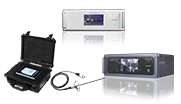Dissolved Gas Monitoring in Transformer Oil
Online monitoring and fault diagnosis technologies for transformers are crucial for enhancing the safety and stability of power systems. Online monitoring based on dissolved gas analysis (DGA) in oil is the most common and critical method for transformer monitoring. Analyzing the composition and concentration of dissolved gases in oil is one of the most effective measures to monitor the safe operation of oil-filled electrical equipment. Photoacoustic spectroscopy (PAS) for dissolved gas analysis in oil features maintenance-free operation, high real-time performance, and high precision.
GIS Gas Tightness Monitoring
With the rapid development of the power and power transmission/distribution industries, an increasing number of high-voltage (HV) and extra-high-voltage (EHV) switchgear have been put into use, simultaneously driving a sharp rise in demand for gas-insulated switchgear (GIS). Sulfur hexafluoride (SF6), an excellent insulating and arc-extinguishing gas, is widely used in GIS. The compartment airtightness of GIS is critical to its service life and maintenance costs. SF6 gas leakage not only endangers the safety and health of personnel but also impacts global climate.
SF6 Decomposition Products Detection
SF6 gas-insulated switchgear (GIS) was once regarded as a product with superior insulation performance and maintenance-free characteristics. However, insulation failures still occur during operation. When partial discharges such as corona, sparks, and arcs occur, SF6 gas in electrical equipment reacts with moisture, oxygen, and solid insulation materials to generate various decomposition products. These products are correlated with the types of partial discharges, enabling fault diagnosis and equipment defect detection based on gas composition analysis.
Battery Thermal Runaway Monitoring
Currently, due to the complex electrochemical reactions inside lithium batteries, thermal runaway of single cells cannot be completely avoided, leading to frequent spontaneous combustion incidents. Therefore, early safety detection of lithium battery thermal runaway is of vital importance. Thermal runaway generates substantial heat and releases high-temperature flammable gases. In battery modules, once thermal runaway occurs, heat spreads to adjacent cells, triggering runaway propagation. In the initial stage, the solid electrolyte interface (SEI) film reacts and decomposes, exposing the negative electrode to the electrolyte and generating gases such as ethane, ethylene, and acetylene. The spontaneous combustion monitoring system tracks the content of various gases, temperature, and pressure emitted by different lithium batteries, providing technical and theoretical support for early identification of thermal runaway risks and a scientific basis for preventing battery fires.








